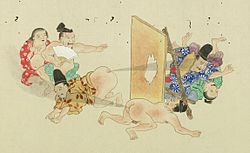He-gassen
| He-Gassen | |
|---|---|
| Japanese: 屁合戦 | |
 A small section of the scroll. | |
| Artist | Unknown artist |
| Year | Edo period |
| Dimensions | 29.6 cm × 1003.1 cm (11.7 in × 394.9 in) |
He-Gassen (Japanese: 屁合戦, literally: "Fart competitions"), or Houhi-Gassen (放屁合戦), are titles given to a Japanese art scroll,[1] created during the Edo period (1603–1868) by an unknown artist or several unknown artists[2][3][4] depicting flatulence humor.
He-Gassen is a subject occasionally depicted in Japanese art, first attested at the end of the Heian Period (794–1185). Toba Sōjō (1053–1140), in addition to his famous Scrolls of Frolicking Animals, is also mentioned as having painted scrolls on themes such as "Phallic Contest" and "He-gassen."[5][6]
Notable examples[edit]
- Kachie Emaki (勝得絵巻) (scroll), anonymous (15th century, copy of earlier work), Mitsui Memorial Museum.
- Houhe Gassen Emaki (放屁合戦絵巻) (scroll; 1449, copy of earlier work) Suntory Museum of Art.
- Houhe Gassen Zu (放屁合戦図) (sliding screen) The Museum of Art, Kōchi.
- Houhe Gassen Emaki (放屁合戦絵巻) (two scrolls) by Kawanabe Kyōsai (1867), Kawanabe Kyosai Memorial Museum (in Warabi, Saitama). Separately, a parody by Kyōsai from 1876, bearing the title Fart Contest as Japan Adopts Western Culture Illustrated Scroll (開化放屁合戦絵巻), is in a private collection.
- Onara Gassen (於那羅合戦) by Ogawa Usen (1921), Fukushima Prefectural Museum of Art.
Waseda University scroll[edit]
One scroll in the possession of the Waseda University Library has been digitized.[7] The Waseda University scroll (reproduced in this article) ends (on the far left) with a colophon, stating that this is a 1846 (弘化三丙午) work by "The Fukuyama painter (福山画師) sixty-nine-year-old Airan (六十九歳 相覧)", being a copy of a 1680 (延宝八) original painted by Hishikawa Moronobu. The artist is possibly Murakata Airan (1778–c.1846). The scroll begins the far right, with a scene of men of various ranks (the lacquered black caps indicate court ranks, the others are commoners) spreading the news of the contest, scenes of men passing along the news and carrying baskets of a certain flatulance-inducing foodstuff (taro), and a cooking scene where the food is being prepared and eaten.
References[edit]
- ^ "japanese-fart-scrolls-prove-that-human-art-peaked-centuries-ago". io9.com. 20 February 2012. Archived from the original on 21 February 2012. Retrieved 20 July 2015.
- ^ "he-gassen-japan-edo-period-fart-scrolls". www.spoon-tamago.com. 7 January 2015. Archived from the original on 21 March 2020. Retrieved 20 July 2015.
- ^ "The Internet Has Officially Discovered The Most Epic Fart Battle In All Of Art History (NSFW)". www.huffingtonpost.com. 23 January 2014. Archived from the original on 8 October 2017.
- ^ "Japanese-fart-battle". wtfarthistory.com. Archived from the original on 31 March 2019. Retrieved 20 July 2015.
- ^ Hosogaiya, Atsushi (2019). "Contents Stream from Emakimono and Ezoushi to Manga". Journal of the Imaging Society of Japan. 58 (5): 513–522.
- ^ Yano, Akiko (2013). "Historiography of the "Phallic Contest" Handscroll in Japanese Art". Japan Review (26): 59–82. JSTOR 41959817. The pertinent discussion is on pages 59-61, citing Kokon Chomonjū (completed in 1254) as the source text that makes the connection between Toba Sōjō and the Phallic Contest theme.
- ^ "Digitized scroll at the Waseda University Library". Archived from the original on 16 September 2014. Retrieved 20 July 2015.
Further reading[edit]
- Henshall, Kenneth (2004). A history of Japan: From Stone Age to Superpower (2nd ed.). Palgrave Macmillan. p. 70. ISBN 1-4039-1272-6.
- Steele, M. William (2003). Alternative Narratives in Modern Japanese History. Routledge, London. p. 14. ISBN 978-1-134-40408-7.
- Yano, Akiko (2013). "Historiography of the "Phallic Contest" Handscroll in Japanese Art". Japan Review (26): 59–82. JSTOR 41959817.
External links[edit]
- Japanese-fart-scrolls
- Digitized scroll at the Waseda University Library
- Japanese fart scrolls prove that human art peaked centuries ago

